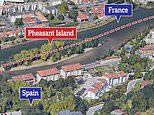
It’s the island with an identity crisis – it’s either French or Spanish, depending on the time of year.
Pheasant Island, an uninhabited isle that lies on the Bidasoa river along the border between France and Spain, is French for one half of the year, while for the other half, it belongs to Spain.
Since the mid-17th century, the island, which measures 200m (660ft) long and 40m (130ft) wide, has been governed by Spain from February 1 to July 31, at which point it is handed over to the French, who rule the isle from August 1 to January 31.
How did the situation come about? In 1659, the island – deemed a neutral space – hosted the signing of the Treaty of the Pyrenees, a peace treaty between Louis XIV of France and Philip IV of Spain that ended the Franco-Spanish War that began in 1635.
As part of the treaty, it was decided that the two countries would alternate command of the island, making it a ‘condominium’ – a territory over which multiple states share equal authority.
Pheasant Island (pictured), set in the Bidasoa river, is French for one half of the year, while for the other half of the year, it belongs to Spain
The uninhabited island measures 200m (660ft) long and 40m (130ft) wide. On the Spanish side is the town of Irun and on the French side the town of Hendaye
An ode to this event, a stone monolith, was erected on the island in 1861 – the side facing Spain is inscribed in Spanish, while French lettering is etched into the side that faces France, the travel site Fascinating Spain reveals.
That wasn’t the only significant historical event to have taken place on this tiny outcrop.
In 1660, Maria Theresa of Spain said goodbye to her father and the Spanish court on the island, before crossing into France to become the wife of the French King Louis XIV.
The event has gone down in the history books as the ‘Meeting on the Isle of Pheasants’.
Later, in 1721, King Louis XV met his prospective wife Mariana Victoria of Spain on the island. Alas, they never wed, as Louis went on to marry Marie Leszczynska, a member of a prominent Polish noble family.
What’s more, Basque Country Tourism reveals that ‘the island has also been used throughout history for hostage exchanges’.
Though its name suggests otherwise, there are no pheasants to be found on the island. According to Fascinating Spain, when the Romantic writer Victor Hugo visited the isle in 1843, he lamented seeing ‘at most a cow and three ducks’, but no pheasants.
Today, access to the island is limited – it may only be visited by the public on special heritage days that have been arranged to commemorate the historic treaty.
The island is a ‘condominium’ – a territory over which multiple sovereign forces share equal power
A stone monolith was erected on the island in 1861 to commemorate the signing of the Treaty of the Pyrenees. As part of the treaty, Spain and France alternate governance of the island
A painting by the artist Jacques Laumosnier depicts the 1660 meeting of France’s Louis XIV and Philip IV of Spain, ahead of the French King’s proposed marriage to Maria Theresa of Spain
As the Bidasoa river is tidal, with water flowing into the Cantabrian Sea, the island can sometimes be reached by foot from Spain.
The Basque town of Irun is set on the Spanish side of the river. After taking in the view of Pheasant Island from the riverbanks, visitors can admire the town’s ancient Roman baths and dine out in an array of Basque restaurants.
Over on the French side of the river, meanwhile, there’s Hendaye, a Basque seaside town that offers travellers sandy beaches and a 19th-century chateau.
The local councils of both Irun and Hendaye take responsibility for maintaining the island, reaching it by boat to cut back its undergrowth and prune its trees.
Above is a bird’s eye view of the Basque town of Irun and the landscape that surrounds it
Source link
CHECK OUT: Top Travel Destinations
READ MORE: Travel News



